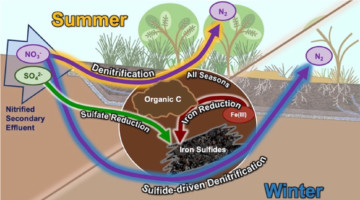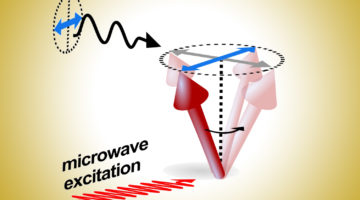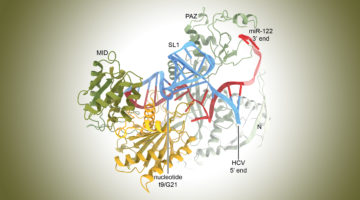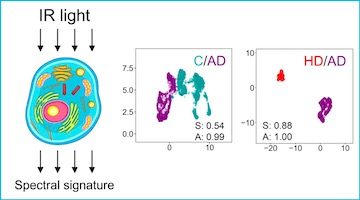Treated municipal wastewater often contains nitrogen, which has been linked to algal blooms that can devastate coastal ecosystems. In a recent study, researchers characterized the primary nitrogen-removal pathways in a horizontal levee, an engineered subsurface water-treatment system consisting of a gently sloping strip of land adjacent to storm-control levees. Read more »
Science Briefs
Looking Inside a Battery with Infrared Light
Researchers have developed a new infrared methodology with unparalleled spatial and chemical imaging capabilities that helps to characterize processes at the interfaces between electrodes and electrolytes, with an eye toward bringing increased safety, lifetime, and energy density to the next-generation solid-state battery market. Read more »
Dynamic Measurements of Antiferromagnetically Aligned Spins
Researchers developed a technique that enables time-resolved, direct detection of spin currents in either ferromagnetic or antiferromagnetic materials at GHz frequencies. Studying the dynamic properties of antiferromagnetic spintronic effects could lead to greater stability and faster intrinsic switching speeds compared to conventional spintronics. Read more »
Key to Coral Resilience Is Faster Skeletal Crystallization
In a new study, researchers show that the crystallization rate of coral skeletons differs across species and is correlated with their resilience to ocean acidification. The results have implications for predicting coral reef survival and developing mitigation strategies against having their bony skeletons weakened by ocean acidification. Read more »
Molecular Hijacking of a MicroRNA by the Hepatitis C Virus
The hepatitis C virus (HCV), which attacks the liver, is known to repurpose host-cell components known as microRNAs—short RNA strands that act to silence gene expression. Now, the molecular structure of an HCV site bound to a microRNA complex revealed how their interactions shield the virus from the host cell’s protective response. Read more »
A Brighter Future for Stretchable Electronics
By continuously monitoring physiological signals, wearable “stick-on” sensors not only help people stay healthy, they can also provide early warning of potential health problems. At the ALS, researchers studied the morphology of such a sensor’s active material, which is key to controlling and optimizing its structure and performance. Read more »
A Photoelectrode Protection Scheme for Solar-Fuel Production
Microscopy, spectroscopy, and computational studies of a promising artificial-photosynthesis material led researchers to develop a model photoelectrochemical (PEC) cell with remarkable stability and longevity as it selectively converts sunlight and carbon dioxide into two promising sources of renewable fuels—ethylene and hydrogen. Read more »
Rapid 3D Visualization of Lung Cells Altered by SARS-CoV-2
In this work, researchers illustrated the potential of soft x-ray tomography to rapidly characterize and quantify the structural changes induced in cells infected by SARS-CoV-2, revealing profound alterations of the subcellular architecture induced by viral infection over time. Read more »
How Shark Egg Cases Balance Toughness and Permeability
Also known as “mermaid’s purses,” shark egg cases are both tough and permeable—two opposing characteristics that are necessary for the embryo’s survival. X-ray scattering at the ALS and electron microscopy helped explain how the material’s nanoarchitecture contributes to its toughness, informing future development of high-performance synthetic materials. Read more »
Spectral Phenotyping for Early Detection of Alzheimer’s Disease
Early detection of Alzheimer’s disease may soon be within reach, thanks to spectral phenotyping. Using infrared spectroscopy, Berkeley Lab researchers developed this technique to detect the subtle biochemical changes in a “cellular fingerprint” that is characteristic of the devastating disease. Read more »
- « Previous Page
- 1
- …
- 5
- 6
- 7
- 8
- 9
- …
- 23
- Next Page »









